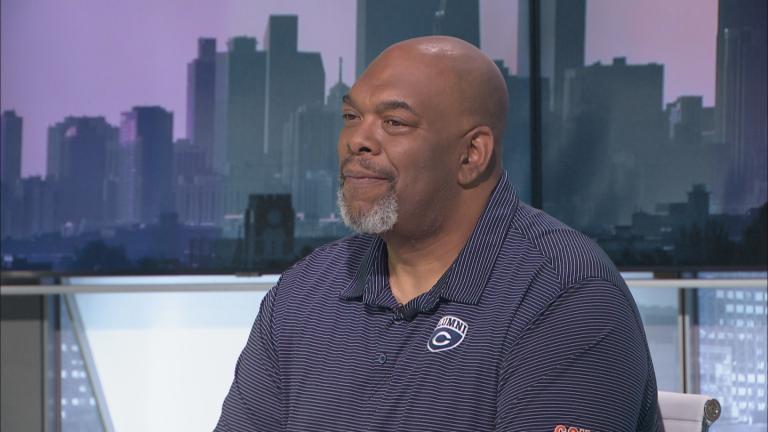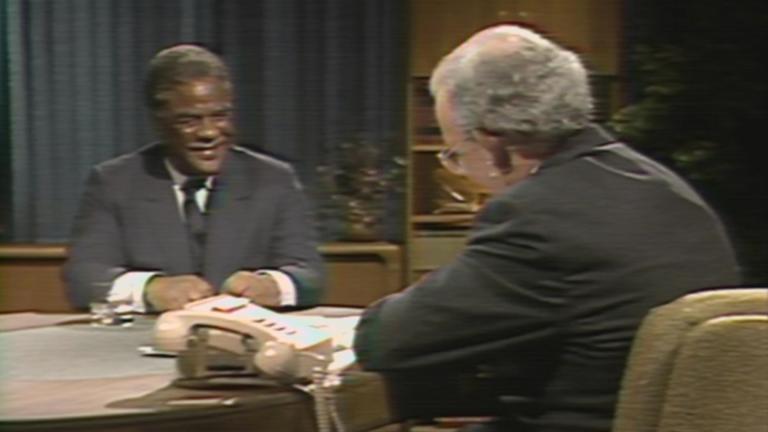James Lee Williams can relate to the one of the videos playing at the “Evicted” exhibit at the National Public Housing Museum in River North.
“It’s touching,” Williams said. “It’s about a woman pouring out her heart because she lost everything.”
Williams said he lost everything after he was run over by a car. The crash left him with leg injuries that prevented him from working his construction job.
“My money ran out, I wasn’t getting no check,” he said. “I was evicted.”
Williams said he is still homeless, couch surfing with friends and family while maintaining a picture-perfect exterior.
“I just played a role with people like, ‘Yeah, I still stay here, in this house right here,’” Williams said. “And all along I don’t stay there in that house. All along, I’m staying here. In summertime I might sleep in my car some days, go to the hotel.”
The role Williams plays at the River North museum is educator. He helps visitors better understand the impact of eviction on those who experience it.
“I didn’t pay rent for a couple of months, and they came, got me, said I gotta go,” Williams said. “Most of my stuff got destroyed. I got most of my stuff, but then I started putting all my stuff in storage.”
He said many of his belongings are spread across the homes of different friends and relatives.
Part of the exhibit includes a sculptural piece of shrink-wrapped items that might be found in a home. It references what Williams and so many others experience when evicted.
“So suddenly, all of their most precious family objects are ripped out of their home, bound up,” said Lisa Yun Lee, the museum’s executive director. “And in the United States, what happens is, there’s often predatory moving companies that come, take the objects and put them into a storage facility. And unless the family has enough money, they’ll never get their objects back. … So all throughout the nation, there are these warehouses filled with people’s most precious objects.”
The exhibit is inspired by the Pulitzer Prize-winning book “Evicted” by Princeton sociologist Matthew Desmond. The museum relies on educators, like Williams and Efren Paderes, who is also homeless. But it also uses numbers.
The goal is to illuminate the harsh reality of evictions for low-income renters.
“In Chicago alone, last year, we had over 24,000 evictions,” Lee said. “So, we’re up there as a city.”
Research published in PNAS (Proceedings of the National Academy of Sciences) shows that in the U.S. 7.6 million people were threatened with eviction each year between 2007 and 2016. Nearly 3 million of them were children.
The numbers also show the disproportional impact on Black residents, especially women.
“In the research community, there’s a saying, that as we lock Black men up, Black women are locked out,” Lee said, pointing to the part of the exhibit using black and yellow keys depicting the disproportionate impact on Black women.
“Black women are at most risk for eviction in the U.S.,” Lee said.
Though Black people make up only 18.6% of renters, they account for 43% of those who are evicted, according to the research.
For Black women with children, the eviction filing rate was 28.4%, compared to the overall filing rate for adults with children at 10.4%.
“Some people think, ‘Oh, people who’re evicted don’t have jobs,’” Lee said. “Actually, we have people who’re working with us who are hustling. They actually might have three jobs. But because of the housing affordability crisis, they still can’t afford to actually live somewhere.”
Paderes said he works but isn’t paid enough to afford rent.
Sometimes he stays with friends, but mostly, he sleeps outside.
“First, I was just staying by the train mostly — not the safest place,” Paderes said. “I’ve been robbed twice, been assaulted twice.”
He said he’s never been evicted but knows the pain.
“I’d like for people to empathize with people who lost their homes being evicted and such because when you lose your home, you lost private space,” Paderes said. “You lose your space where you can be safe, where you can be yourself. It’s hard to find another place like that.”
Williams said the struggle is enough to make him consider his old ways. Years ago, he was sent to prison for bank robbery.
But today, he said he has a good reason to stay hopeful for a better future.
“My daughter keeps me out of prison,” Williams said. “Because I want her to have the best. My daughter keeps me out of prison.”
Paderes, Williams and other educators for the exhibit are participants with Red Line Service, an organization that provides support for artists who are or have been homeless.
The “Evicted” exhibit runs through March 10 at the National Public Housing Museum.
Note: This article was first published Feb. 22, 2024. An updated video was added Feb. 28, 2024.








